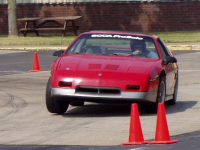HAL trigger M code
- Todd Zuercher
-

- Offline
- Platinum Member
-

Less
More
- Posts: 4686
- Thank you received: 1433
27 Feb 2025 16:25 #322798
by Todd Zuercher
Replied by Todd Zuercher on topic HAL trigger M code
Ideally your g-code should be designed and generated in a fashion that the tool is actually capable of achieving the programed feed rates. It isn't really a good practice to program code to execute at say F200 but the moves will only allow F40 and then expect to rely on that F40 as your feed.
Right now since the machine is trying to cut at the higher feed in the slow sections but "can't". When you slow the machine with the feed override, the slow sections will not slow down until the feed override percentage lowers the programmed feed rate below the actual capabilities of the machines parameter settings for those sections of code. So if the programmed feed is F200 but the machine can only reach F40 in a section, you would not see a reduction in feed in the slow section until the feed override is set below 20%.
If you were to insert realistic feed rates for the "slow" sections of code. Then the feed override should give you the results you are wanting.
Other things to do to improve this would be to increase the machine's acceleration capabilities in order to reduce affect of slowdowns caused by short moves. Run the code using G64 mode with more optimal blending settings (larger P and or Q tolerances.). Improve G-code optimization by using curves instead of approximating them with short line segments, increasing code segment lengths and making segments more co-linear (less corners). Really any thing you can do to make so the machine moves at the actual programmed g-code feed rate rather than at the limits imposed by the configuration settings/physical limitations.
Right now since the machine is trying to cut at the higher feed in the slow sections but "can't". When you slow the machine with the feed override, the slow sections will not slow down until the feed override percentage lowers the programmed feed rate below the actual capabilities of the machines parameter settings for those sections of code. So if the programmed feed is F200 but the machine can only reach F40 in a section, you would not see a reduction in feed in the slow section until the feed override is set below 20%.
If you were to insert realistic feed rates for the "slow" sections of code. Then the feed override should give you the results you are wanting.
Other things to do to improve this would be to increase the machine's acceleration capabilities in order to reduce affect of slowdowns caused by short moves. Run the code using G64 mode with more optimal blending settings (larger P and or Q tolerances.). Improve G-code optimization by using curves instead of approximating them with short line segments, increasing code segment lengths and making segments more co-linear (less corners). Really any thing you can do to make so the machine moves at the actual programmed g-code feed rate rather than at the limits imposed by the configuration settings/physical limitations.
The following user(s) said Thank You: tommylight
Please Log in or Create an account to join the conversation.
Time to create page: 0.263 seconds
